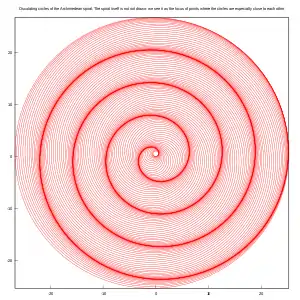Tait–Kneser theorem
In differential geometry, the Tait–Kneser theorem states that, if a smooth plane curve has monotonic curvature, then the osculating circles of the curve are disjoint and nested within each other.[1] The logarithmic spiral or the pictured Archimedean spiral provide examples of curves whose curvature is monotonic for the entire curve. This monotonicity cannot happen for a simple closed curve (by the four-vertex theorem, there are at least four vertices where the curvature reaches an extreme point)[1] but for such curves the theorem can be applied to the arcs of the curves between its vertices.

The theorem is named after Peter Tait, who published it in 1896, and Adolf Kneser, who rediscovered it and published it in 1912.[1][2][3] Tait's proof follows simply from the properties of the evolute, the curve traced out by the centers of osculating circles. For curves with monotone curvature, the arc length along the evolute between two centers equals the difference in radii of the corresponding circles. This arc length must be greater than the straight-line distance between the same two centers, so the two circles have centers closer together than the difference of their radii, from which the theorem follows.[1][2]
Analogous disjointness theorems can be proved for the family of Taylor polynomials of a given smooth function, and for the osculating conics to a given smooth curve.[1]
References
- Ghys, Étienne; Tabachnikov, Sergei; Timorin, Vladlen (2013), "Osculating curves: around the Tait–Kneser theorem", The Mathematical Intelligencer, 35 (1): 61–66, arXiv:1207.5662, doi:10.1007/s00283-012-9336-6, MR 3041992
- Professor Tait (February 1895), "Note on the Circles of Curvature of a Plane Curve", Proceedings of the Edinburgh Mathematical Society, 14: 26, doi:10.1017/s0013091500031710
- Kneser, Adolf (1912), "Bemerkungen über die Anzahl der Extreme der Krümmung auf geschlossenen Kurven und über verwandte Fragen in einer nicht-euklidischen Geometrie", Festschrift Heinrich Weber zu seinem siebzigsten Geburtstag am 5. März 1912 gewidmet von Freunden und Schülern; mit dem Bildnis von H. Weber in Heliogravüre und Figuren im Text, Leipzig: B. G. Teubner, pp. 170–180